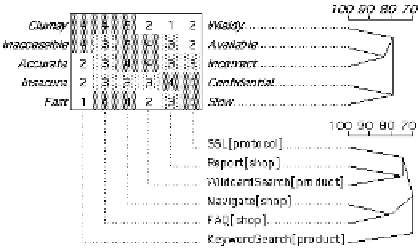Information Technology Reference
In-Depth Information
(a)
(b)
Fig. 5.
A sample repertory grid for the media shop.
a
Display of repertory grid.
b
Cluster analysis of repertory grid.
respect to the poles of each construct. The construct poles to the left of the grid
are the “1” end of the scale, and those to the right are the “5” end. The occur-
rence of the central point “3” in a grid can have two different interpretations: 1.
Neutral:
the element is at neither one pole nor the other of the construct. 2.
Not applicable or unknown:
the element is outside the range of convenience
of the construct. For example, the element “Report[shop]” is not pertinent to
the construct “Inaccessible-Available”. Therefore, a rating of “3” appears in the
fifth row and the fourth column of Fig. 5a.
The most interesting feature of RGT is the wide variety of different types
of analyses that can be applied to the gathered personal constructs. In our
approach, the FOCUS program [42] is used to perform a two-way hierarchical
cluster analysis, and to reorder the grid so that similarly rated elements are
adjacent and similarly used constructs are adjacent.
Figure 5b shows the reordered media shop sample grid. The upper and lower
dendrograms illustrate the strength of association between constructs and be-
tween elements respectively. To highlight the clusters within the grid, ratings of
four and five are given dark shading, ratings of three are given light shading,
and ratings of one and two are left unshaded. This enables the easy identifica-
tion of “blocks” within the grid [42]. For example, the top left cluster in Fig. 5b
shows that keyword search, FAQ, and navigation are similar with respect to
the “Clumsy-Wieldy” criterion in this particular context. Next, we show how
to leverage RGT to align candidate aspects regarding to different stakeholder
vocabularies.
3.2
Early Aspects Alignment Via Repertory Grid Technique
A competent early aspects framework shall provide mechanisms to avoid tangling
of distinct concepts expressed in the same term, and to prevent scattering of one
concept over dissimilar lexicons. We present a novel use of RGT with roots in
PCT as a means of addressing terminological problems in different viewpoints


Search WWH ::

Custom Search